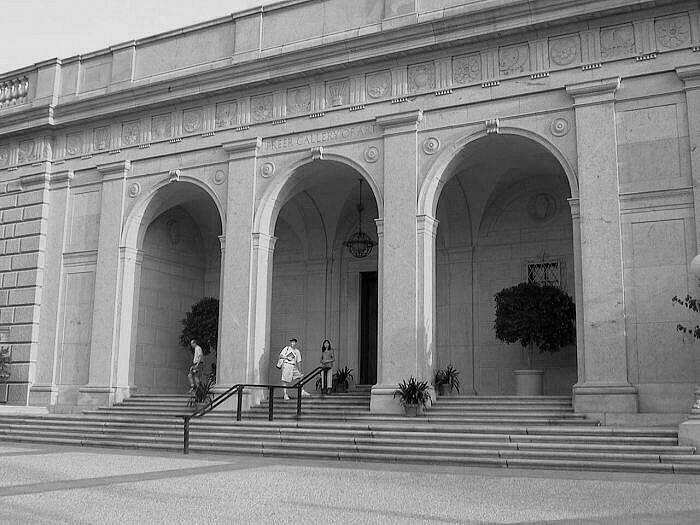- Freer Gallery of Art
Infobox nrhp
name = Freer Gallery Of Art
nrhp_type =

caption = The entrance to the Freer Gallery
location =12th St. and Jefferson Dr., SWWashington, D.C.
nearest_city =
lat_degrees =
lat_minutes =
lat_seconds =
lat_direction =
long_degrees =
long_minutes =
long_seconds =
long_direction =
area =
built =
architect =Charles A. Platt
architecture =
added =June 23 ,1969
visitation_num =
visitation_year =
refnum =69000295
mpsub =
governing_body = The Freer Gallery of Art is theSmithsonian Institution 's museum ofEast Asian art, includingart fromEast Asia (China, Korea, Japan),South Asia (India ), andsoutheast Asia , as well asAmerican art . The Freer is one of two galleries of the National Museum of Asian Art, the other being the Sackler Gallery. It opened to the general public in 1923. It is located on the south side of theNational Mall inWashington, D.C. Visitor favorites include
Chinese ceramics andChinese painting s,Korean Ceramics , andKorean pottery , Japanese folding screens, Indian and [http://www.asia.si.edu/exhibitions/online/loveyearning/default.htm Persian manuscripts] , and Buddhist sculpture from various regions and time periods. The artwork of the gallery ranges fromNeolithic to modern, with multitudes of painted art mostly from theSong Dynasty ,Ming Dynasty , andQing Dynasty of China.History
The gallery was founded by
Charles Lang Freer (1854–1919), a railroad-car manufacturer from Detroit who gave to the United States his collections and funds for a building to house them. The Italian-Renaissance-style gallery, constructed in granite and marble, was inspired by Freer's visits to palazzos in Italy and designed by the American architectCharles A. Platt . When the gallery opened to the public in 1923, it was the first Smithsonian museum dedicated to fine arts. The Freer was also the first Smithsonian museum created from a private collector's bequest. Freer's bequest to the Smithsonian came with the proviso that he would execute full curatorial control over the collection until his death. The Smithsonian initially hesitated at the requirements but the intercession of PresidentTeddy Roosevelt allowed for the project to proceed. In subsequent years, the [http://www.asia.si.edu/collections/default.htm collections] have grown through gifts and purchases to nearly triple the size of Freer's bequest.A highlight of the [http://www.asia.si.edu/exhibitions/online/whistler/whistlerdefault.htm Whistler] holdings is the [http://www.asia.si.edu/exhibitions/current/peacock.htm Peacock Room] , a dining room designed for the British shipping magnate F.R. Leyland. In 1876, Whistler lavishly decorated the room with a blue and gold peacock design. After the owner's death, Freer purchased the room in toto and had it shipped to the United States and permanently installed in the [http://www.asia.si.edu/ Freer Gallery] .
The adjoining
Arthur M. Sackler Gallery was opened in 1987 to house a gift of some 1,000 works of Asian art from Dr.Arthur M. Sackler (1913–1987), a research physician and medical publisher from New York City. Among the highlights of his gift were early Chinese bronzes and jades, Chinese paintings and lacquerware, ancient Near Eastern ceramics and metalware, and sculpture from South and Southeast Asia. Sackler also donated $4 million toward construction of the gallery. Since 1987, the gallery's collections have expanded to include the Vever Collection, an important assemblage of the Islamic arts of the book from the 11th to the 19th century; 19th- and 20th-century Japanese prints and contemporary porcelain; Indian, Chinese, Japanese, and Korean paintings; arts of village India; contemporary Chinese ceramics; and photography.International loan exhibitions have included "Timur and the Princely Vision: Persian Art and Culture in the 15th Century"; "Yani: the Brush of Innocence", featuring paintings by a 14-year-old Chinese prodigy; "When Kingship Descended from Heaven: Masterpieces of Mesopotamian Art from the Louvre"; "Court Arts of Indonesia"; "Korean Art of the 18th Century": Splendor & Simplicity; and "A Basketmaker in Rural Japan".The Sackler Gallery is connected by an underground exhibition space to the neighboring Freer Gallery of Art. Although their collections are stored and exhibited separately, the two museums share a director, administration, and staff.
The Eugene and Agnes E. Meyer Auditorium, located in the Freer, provides a venue for a broad variety of free public programs relating to the collections of the Freer and Sackler galleries, including concerts of Asian music and dance, films, lectures, chamber music, and dramatic presentations [http://www.asia.si.edu/visitor/history.htm] .
Care of the collections began before the museum came into existence as Charles Lang Freer, the founder of the Freer Gallery of Art, hired Japanese painting restorers to care for his works and to prepare them for their eventual home as part of the Smithsonian Institution. In 1932, the Freer Gallery of Art hired a full-time Japanese restorer and created what was to become the East Asian Painting Conservation Studio. The Technical Laboratory, and the first use of scientific methods for the study of art at the Smithsonian Institution, started in 1951 when the chemist Rutherford J. Gettens moved from the Fogg Museum at Harvard University to the Freer. The East Asian Painting Conservation Studio and the Technical Laboratory merged in 1990 to form the Department of Conservation and Scientific Research [http://www.asia.si.edu/visitor/conservation.htm] .
Gallery
China
India
Egypt
Japan
Nepal
Persia
Korea
yria
Kushan
ee also
*
Chinese painting
*History of art
*History of painting
*Indian art
*Islamic art
*Japanese painting
*Lin Tinggui
*Pewabic Pottery
*Zhou Jichang External links
* [http://www.asia.si.edu/ Freer Gallery of Art]
Wikimedia Foundation. 2010.
